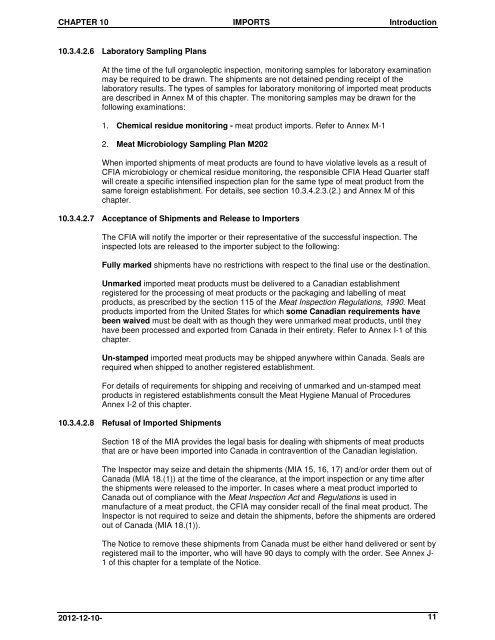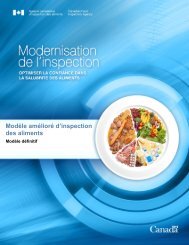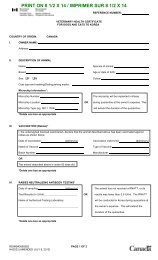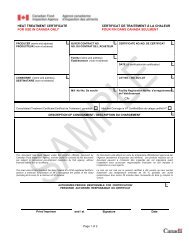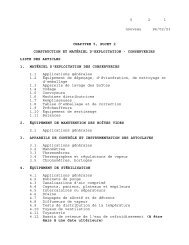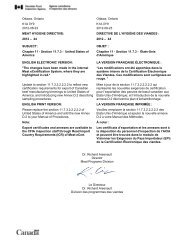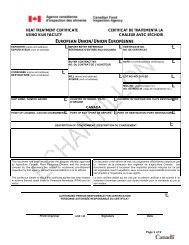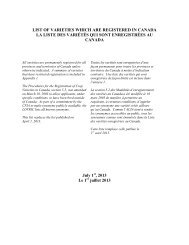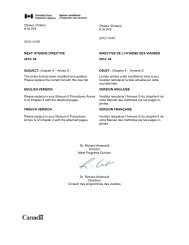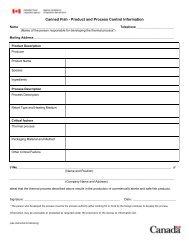PDF (342 kb ) - Agence canadienne d'inspection des aliments
PDF (342 kb ) - Agence canadienne d'inspection des aliments
PDF (342 kb ) - Agence canadienne d'inspection des aliments
You also want an ePaper? Increase the reach of your titles
YUMPU automatically turns print PDFs into web optimized ePapers that Google loves.
CHAPTER 10 IMPORTS Introduction10.3.4.2.6 Laboratory Sampling PlansAt the time of the full organoleptic inspection, monitoring samples for laboratory examinationmay be required to be drawn. The shipments are not detained pending receipt of thelaboratory results. The types of samples for laboratory monitoring of imported meat productsare <strong>des</strong>cribed in Annex M of this chapter. The monitoring samples may be drawn for thefollowing examinations:1. Chemical residue monitoring - meat product imports. Refer to Annex M-12. Meat Microbiology Sampling Plan M202When imported shipments of meat products are found to have violative levels as a result ofCFIA microbiology or chemical residue monitoring, the responsible CFIA Head Quarter staffwill create a specific intensified inspection plan for the same type of meat product from thesame foreign establishment. For details, see section 10.3.4.2.3.(2.) and Annex M of thischapter.10.3.4.2.7 Acceptance of Shipments and Release to ImportersThe CFIA will notify the importer or their representative of the successful inspection. Theinspected lots are released to the importer subject to the following:Fully marked shipments have no restrictions with respect to the final use or the <strong>des</strong>tination.Unmarked imported meat products must be delivered to a Canadian establishmentregistered for the processing of meat products or the packaging and labelling of meatproducts, as prescribed by the section 115 of the Meat Inspection Regulations, 1990. Meatproducts imported from the United States for which some Canadian requirements havebeen waived must be dealt with as though they were unmarked meat products, until theyhave been processed and exported from Canada in their entirety. Refer to Annex I-1 of thischapter.Un-stamped imported meat products may be shipped anywhere within Canada. Seals arerequired when shipped to another registered establishment.For details of requirements for shipping and receiving of unmarked and un-stamped meatproducts in registered establishments consult the Meat Hygiene Manual of ProceduresAnnex I-2 of this chapter.10.3.4.2.8 Refusal of Imported ShipmentsSection 18 of the MIA provi<strong>des</strong> the legal basis for dealing with shipments of meat productsthat are or have been imported into Canada in contravention of the Canadian legislation.The Inspector may seize and detain the shipments (MIA 15, 16, 17) and/or order them out ofCanada (MIA 18.(1)) at the time of the clearance, at the import inspection or any time afterthe shipments were released to the importer. In cases where a meat product imported toCanada out of compliance with the Meat Inspection Act and Regulations is used inmanufacture of a meat product, the CFIA may consider recall of the final meat product. TheInspector is not required to seize and detain the shipments, before the shipments are orderedout of Canada (MIA 18.(1)).The Notice to remove these shipments from Canada must be either hand delivered or sent byregistered mail to the importer, who will have 90 days to comply with the order. See Annex J-1 of this chapter for a template of the Notice.2012-12-10- 11


